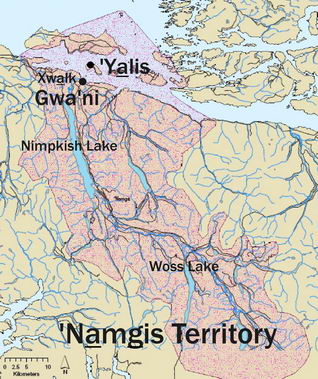By Emma Posluns
With information from Doug Aberley, Treaty Coordinator

The home community of the ‘Namgis Nation is located on Cormorant Island which is two kilometers from Northern Vancouver Island. The traditional territory of the ‘Namgis covers a much larger 2,800 square kilometer area, which offers many resources for potential development including minerals, forests, energy, and marine resources. The Nation receives up to two hundred “Crown” land referrals each year, and does its best to answer to most of them.
The Treaty and Natural Resources Office answer referrals. Staff work simultaneously on treaty negotiation, planning, economic development and land referrals, thus they can judge each referral in relation to broader land use planning and economic development goals of the Nation. Using this approach, the ‘Namgis utilize the talents of a cultural resource officer, two land planners, a GIS technician, three fisheries staff, and a forester. Different types of referrals are routed to these individuals using a paper tracking system. When asked whether or not an electronic tracking system would be more efficient, Doug Aberley, the Treaty Coordinator for the ‘Namgis Nation, said that he is “not convinced that technology is always the way to go”. He insists that “old-fashioned” paper systems can be very efficient and organized; it just depends on the office.
When it comes to accommodation of the ‘Namgis in proposed projects, it is not always good to do things the “old fashioned way”. The ‘Namgis have a firm policy to attempt to gain an equity share of all sustainable economic development projects proposed to be undertaken in their territory. For example, when meeting with Polaris Minerals about a proposed gravel extraction development, the Namgis negotiated a 12% ownership stake in the project. This move dramatically changed the way the ‘Namgis processed referrals related to the project. In the past, the Nation may not have had the resources and capacity to handle referrals the way they wanted to, however today they have the ability to complete as detailed a review of project referrals as they deem necessary.
The ‘Namgis have also advanced when it comes to participating in environmental impact assessments for projects located in their territory. Traditionally, outside interests control environmental impact assessments (EIA). The EIAs typically cover a narrow ‘footprint’ directly occupied by proposed project activity. By gaining an equity share of economic development projects, the ‘Namgis can take a better approach to the EIA process. For example, Brookfield Power and the ‘Namgis First Nation currently are partners in a joint-venture to develop two run-of-the-river hydro projects. In both cases, all the watersheds within which the projects are located are being assessed for potential environmental and social impacts. The terms of reference for assessment work are jointly developed by the ‘Namgis and their business partner. Accommodation of ‘Namgis in this project has lead to a strong partnership, a strong referral/environmental assessment process, and 50+ megawatts of new green power for the area.
Individual nations should make their own decisions concerning land use instead of creating unanimous responses put together by multiple nations. Currently, British Columbia is pushing for groups of First Nations to coordinate the process of responding to referrals. The ‘Namgis do not support this ‘streamlining’ approach to allowing centralized referral bureaucracies to be formed. If a First Nation can develop the internal capacity to handling “Crown” land referrals, then this talent can be used for many other beneficial activities!
The ‘Namgis Treaty and Natural Resources Department has come a long way since they started answering “Crown” land referrals three years ago. Based on strong direction from Council, each staff member who participates in the referral process seeks to extend the political and economic power of the ‘Namgis First Nation within its territory. As well, they have realized the importance of involving the wider ‘Namgis community by making all levels of the referrals process as transparent as possible.

